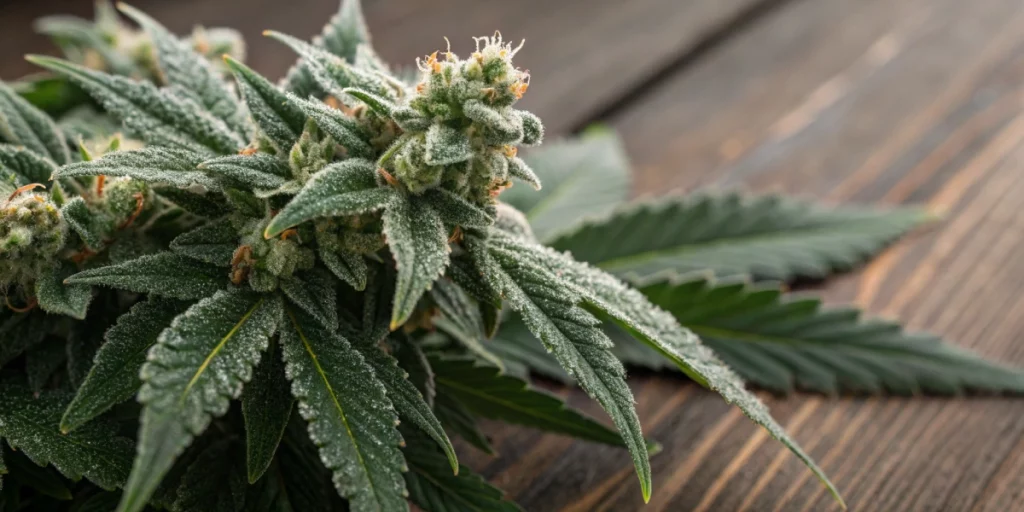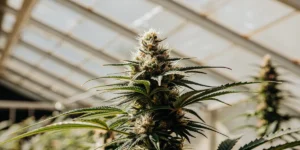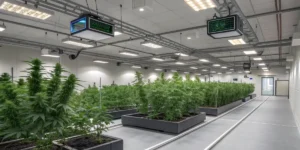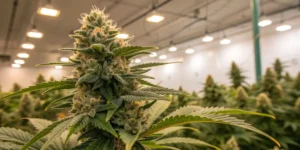Imagine walking into a grow room where every plant bulges with crystal‑covered buds that smell like fresh pine and citrus. That is what happens when you cultivate Ice strain under the right conditions. You will learn how this hybrid’s hardy genetics speed up growth, how to set up the perfect light, and how to avoid pitfalls that slow flowering. Keep reading to find out steps that guarantee top‑quality buds, from seed sprout to the first frost.
Ice strain: Exceptional Genetics and Effects
Origins and Genetics
Breeders created Ice strain by crossing three legendary varieties: Northern Lights, Skunk, and Shiva. The goal was to combine the resin‑laden buds of Shiva with the earthy aroma of Skunk and the powerful yield of Northern Lights. Through careful selection over generations, they preserved traits that produce dense, frosted flowers and sturdy plants. Today, these seeds offer growers a stable and predictable phenotype that performs well indoors and outdoors alike under various grow methods.
Genetic stability in Ice strain means each plant develops similar branch spacing, leaf shape, and bud structure, making training and pruning straightforward. Growers notice thick stems that support heavy flower clusters without bending. Whether cultivated in soil, coco, or hydroponics, it exhibits consistent terpene profiles with sweet pine, diesel, and lemon notes. This uniformity reduces surprises during flowering, letting growers focus on refining nutrient schedules and light cycles to maximize trichome production and aroma.
Effects and Potency
Users of Ice strain often praise its balanced high that lifts mood and eases tension. THC levels average around 20%, delivering a clear mental buzz with gentle body relaxation. Beginners find the onset smooth, avoiding anxious spikes. Seasoned users appreciate the lasting calm that follows initial energy. Flavor notes of pine, sweet citrus, and diesel add depth to the experience, making each inhale memorable while keeping the mind focused.
The potent resin coating on buds makes it ideal for extracts and concentrates. Trichomes shine under magnification, reflecting its high cannabinoid content. The flavor profile remains consistent whether smoked or vaporized, offering a smooth, clean throat hit. Medicinal users report relief from stress, pain, and mild inflammation without heavy sedation. This versatility adds value, letting growers and consumers appreciate Ice strain across different consumption methods — especially when exploring Ice Cream Cake Autoflower, known for its rich flavor and powerful effects in a compact, fast-growing format.
Environmental Requirements for Growing Ice strain
Setting Up the Growing Cannabis Space
Choose a grow space that fits the number of Ice strain plants you plan. Whether a grow tent, closet, or room, ensure proper ventilation. Install an exhaust fan near the canopy to remove hot air and an intake vent low to draw fresh air. Position oscillating fans to create gentle airflow around leaves, reducing stale pockets where mold can form. Clean, well‑ventilated spaces let plants focus on growth without environmental stress slowing development.
Line walls with reflective material like Mylar or white paint to bounce light back onto lower buds, promoting even development. Seal entry points with light‑proof covers to prevent leaks and light stress. Use a timer to maintain consistent photoperiods, signaling flower and veg stages reliably. Consistency in lighting prevents unwanted shifts in growth that could confuse Ice strain plants. For genetics like Ice Cream Cake Autoflower, stable schedules help maximize bud sites and terpene production over the flowering cycle.
Temperature and Humidity
Keep temperatures between 20 and 26°C in the day and around 18°C at night. During vegetative growth, aim for 40–60% humidity to support healthy leaf development. Once flowering begins, lower humidity to 35–45% to protect dense flowers from mold. Use a reliable hygrometer and dehumidifier or humidifier to stabilize conditions. Stable temperature and humidity help Ice strain show its full potential without stress or disease.
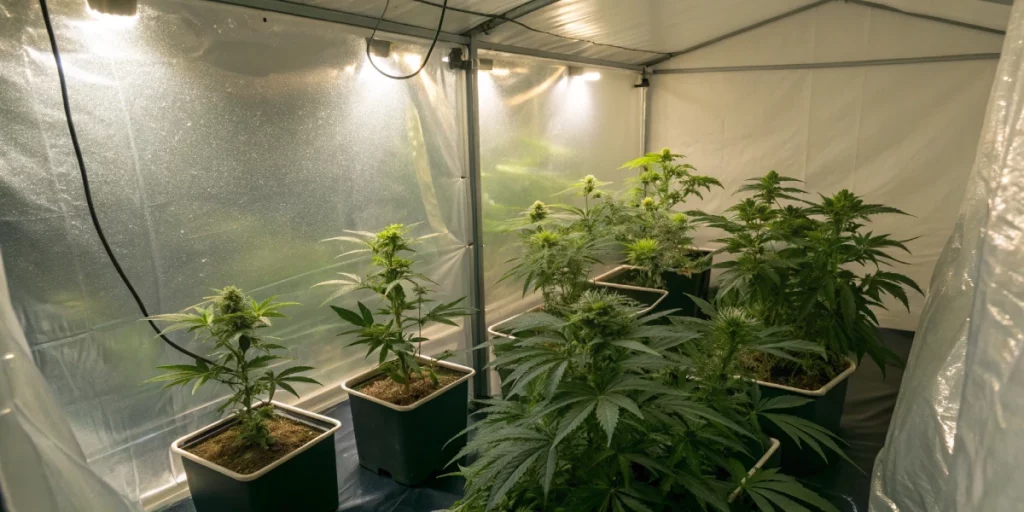
Indoor Cannabis Cultivation
Advantages of Growing Indoors
Growing indoors gives you full control over every aspect of Ice strain’s development. You can adjust light hours precisely to trigger vegetative or flowering stages without waiting for seasons to change. Steady temperatures, humidity, and airflow reduce risks from pests and weather, letting you focus on training techniques. Compact plants stay under 100 cm tall, fitting well in small tents or closets. Indoor grows offer privacy and predictability, making it easier to produce consistent, high‑quality buds year‑round.
Autoflowering? No. But its photoperiod genetics let indoor growers use techniques like SCROG or SOG to maximize yields. By training branches and controlling canopy height, you expose more bud sites to powerful LED or HPS lights. Clean indoor setups minimize contamination, ensuring the resinous, frosty flowers stay pure. Indoor cultivation also allows you to experiment with CO₂ enrichment or hydroponics to push growth, unlocking higher potency and denser buds.
Lighting Needs
To grow this strain indoors, provide 18 hours of light during vegetative stages and switch to 12/12 for flowering. Full‑spectrum LED lights work efficiently, offering strong penetration with lower heat. Keep lights about 30 cm above the canopy to avoid burning leaves while ensuring even coverage. Adjust height as plants grow to maintain optimal light intensity. A digital timer ensures precise schedules, reducing stress and keeping the plants on a predictable path to bud production.
Outdoor Cannabis Cultivation
Best Conditions for Outdoor Growth
Outdoor growers must choose a sunny location with at least six hours of direct midday sun per day. Soil should be loose, well‑draining, and rich in organic matter. Mix compost or worm castings to boost nutrients and microbial life. Plant outside after the last frost when daytime temperatures stay above 15°C. Use stakes or trellises to support branches against wind, preventing breakage as flower clusters grow heavy.
Protect outdoor plants from heavy rain and humidity spikes by adding a layer of mulch around the base. Mulch helps regulate soil moisture and temperature, offering root protection. Monitor weather forecasts and cover plants during prolonged wet spells. Implement organic pest control like neem oil or beneficial insects to avoid infestations. Outdoor cultivation rewards growers with larger yields and robust bud development when provided with optimal care and monitoring throughout the season.
Advantages of Growing Ice strain
This strain’s rapid flowering cycle makes it stand out among photoperiod varieties. In about eight weeks of flowering, indoor growers can move quickly to harvest, and outdoor crops finish before fall rains. The compact plants rarely exceed one meter, letting you grow in tight spaces. Strong genetics produce consistent yields of dense, trichome‑rich buds. Quick turnover means more harvests per year, increasing productivity for hobbyists and commercial growers alike.
Berry, pine, and diesel aromas shine through each bud, making every batch memorable. Growers appreciate the strain’s thick, sticky flowers that stay healthy until harvest. The frost‑covered buds store well, retaining flavor and potency over months of curing. Whether you smoke, vape, or extract, the smooth flavors and balanced effects satisfy many preferences. This versatility and reliability explain why this strain remains a favorite for growers seeking high‑quality yields with minimal fuss.
Problems in Cultivating Ice strain
Overwatering
Overwatering can harm root health and slow growth. Ice strain roots need oxygen, so avoid keeping soil or medium too wet. Allow the top two centimeters to dry before watering again. Using pots with drainage holes and a mix containing perlite or coco helps water flow freely. Yellowing leaves at the bottom indicate too much moisture. Proper watering schedules prevent root rot and nutrient lockout, helping plants grow strong and flower on time.
Pest Infestations
Pests like spider mites and aphids can attack dense buds and hidden areas. Check plants daily, looking under leaves and at stem joints. Introduce beneficial insects like ladybugs or predatory mites to control infestations naturally. Use neem oil or insecticidal soaps at the first sign of pests. Keeping humidity stable and airflow strong helps deter insects. Early detection and intervention protect yields and ensure healthy plants for a successful harvest.
Similar Strains
Banana Krumble
Banana Krumble offers sweet banana aroma and smooth smoke. It flowers in eight to nine weeks, delivering medium yields of dense, resinous buds. Growers praise its resilience under minor climate changes. The balanced high uplifts mood and eases tension without heavy sedation. This makes it a pleasant daytime option and a fitting companion for growers who enjoy fruity flavors and reliable performance in both indoor and outdoor setups.
Flower Bomb Kush
Flower Bomb Kush is a powerful hybrid that combines Granddaddy Purple and Big Bud genetics. It flowers in around nine weeks, producing heavy yields of thick, fragrant buds. The aroma mixes sweet fruity notes with earthy undertones. Smokers report a relaxing body effect and gentle euphoria, making it ideal for evening use. Growers value its large calyxes and robust branches that support heavy flowers without staking.
White Widow
White Widow is a classic favorite known for its balanced, uplifting effects and heavy resin production. It finishes flowering in eight weeks outdoors in warm climates. Indoor growers report 400 g/m² yields under strong lights. The aroma blends earthy pine with a hint of spice. Its sturdy growth and resistance to mold make it a reliable choice for both novice and expert growers looking for quick, potent harvests.
Week-by-Week Growth Plan for Ice strain
Week 1 – Germination and Seedling Stage
Begin by soaking seeds in clean water for 12–24 hours, then transfer them to moist paper towels inside a warm, dark place. Check daily until taproots appear, then gently place each seed into a starter cube or small pot filled with well‑draining medium. Maintain temperatures near 22 °C and high humidity to encourage root growth. Avoid overwatering at this stage; mist the surface lightly. Healthy seedlings set the foundation for vigorous vegetative growth.
Week 2 – Early Seedling Growth
During this stage, seedlings develop their first true leaves and stabilize root systems. Provide 18 hours of gentle light from LEDs or CFLs, keeping bulbs about 30 cm above the canopy. Maintain consistent moisture in the medium without waterlogging. Introduce a mild nutrient solution at one‑quarter strength if leaves show healthy green growth. Ensure good air circulation to prevent damping‑off disease. Focus on building a sturdy stem and balanced leaf canopy.
Week 3 – Vegetative Growth Begins
In week three, continue vegetative growth by increasing nutrient strength to half of the recommended dose. If seedlings are sturdy, transplant into larger pots (5–10 L) with rich soil. Start low‑stress training by gently bending and tying down shoots to create an even canopy. Keep lighting at 18 hours on and 6 hours off, temperatures between 20–26 °C, and humidity around 55%. Monitor plant health and adjust feeding based on leaf color and growth rate.
Week 4 – Accelerated Vegetative Growth
By week four, plants show vigorous branching and leaf production. Continue topping or fimming to promote multiple colas and distribute growth evenly. Increase nutrient strength to full vegetative dose, focusing on nitrogen for healthy foliage. Prune any lower leaves blocking airflow. Maintain stable environmental conditions and 18/6 light schedule. Adequate root space and steady feeding in this phase ensure robust structure and prepare plants for a smooth transition into flowering.
Week 5 – Flowering Initiation
Switch light schedule to 12 hours on and 12 hours off to trigger flowering. In day 35 to 42, you should notice small white pistils forming at branch nodes. Change nutrient mix to bloom formula higher in phosphorus and potassium. Lower humidity to 45–50% and keep temperatures between 20–24 °C. Remove large fan leaves that shade bud sites to improve light penetration. Gentle support like stakes or trellises helps hold developing flower clusters.
Week 6 – Early Flowering
During week six, flower buds swell and hairs become more pronounced. Continue feeding bloom nutrients at three‑quarter strength to avoid salt buildup. Keep environmental factors stable to prevent stress; humidity should stay near 45% and temperature under 26 °C. Inspect plants daily for pests or mold. If needed, spot treat with organic sprays. Maintain gentle airflow around buds without direct wind. Patience and careful monitoring support healthy bud development.
Week 7 – Mid-Flowering
In week seven, buds become denser and trichomes start turning cloudy. Monitoring resin development helps determine peak harvest time. Feed a light nutrient solution or begin flushing if trichome clarity matches desired effect. Keep lights at full intensity for robust flower growth. Ensure humidity near 40% to reduce mold risk in thick buds. Remove any yellowing leaves and maintain airflow to prevent moisture pockets. This mid‑flower phase is critical for final yield quality.
Week 8 – Late Flowering and Harvest
By week eight, most trichomes appear milky with some amber, indicating peak potency. Stop feeding nutrients and flush medium with clean water for around a week to improve flavor. Harvest plant by cutting branches when trichomes match your preference. Hang buds upside down in a dark, ventilated room at 18–20 °C with 50% humidity for 7–10 days. After drying, consider a two‑week cure in airtight jars, burping daily for best aroma and smoothness.

FAQs about Ice strain
How long does Ice strain take to flower?
Ice strain typically flowers in eight to nine weeks after switching to a 12/12 light cycle indoors. Outdoor plants are usually ready by early autumn when days shorten naturally. Monitor trichomes and pistils for harvest timing. Milky trichomes indicate peak THC, while amber trichomes boost relaxation. Adjust your harvest based on the desired effect. Proper drying and curing after harvest enhance flavor, aroma and potency.
What yield can I expect from Ice strain?
Under optimal indoor conditions, growers report 400 to 500 grams per square meter yield from Ice strain. Outdoors, single plants can produce 300 to 600 grams, depending on climate and care. Rich soil and regular feeding boost bud size and density. Training techniques like SCROG and topping maximize light penetration for larger yields. Consistent monitoring and timely pruning help prevent stress, ensuring healthy, productive harvests. For those looking to explore other high-yielding options, the Banana Kush Cake Automatic offers excellent performance and quality buds.
Is Ice strain beginner-friendly?
Ice strain suits beginners due to its resilience and straightforward requirements. Its sturdy branches and thick leaves handle common errors like slight nutrient imbalances and fluctuating humidity levels. photoperiod genetics require managing light cycles, but with basic care, stable temperatures and simple training like LST, novice growers achieve solid, resinous buds. Patience and checks lead to rewarding harvests.

